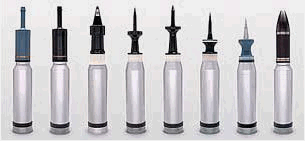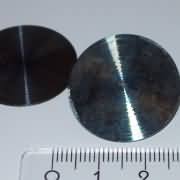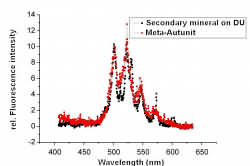Scientist from the Research Center Rossendorf, Germany together with colleagues from the University of Reading, UK studied the behaviour of depleted uranium ammunition on agricultural soils. They found that metallic uranium gets oxidized on the surface to form an uranyl salt that is soluble and therefore sufficiently mobile to reach the groundwater or being taken up by plants and therefore entering the food chain.
Background:Depleted uranium (DU) remains after the fissile isotope 235U has been extracted from natural Uranium for the production of nuclear fuel or nuclear weapons. However 235U only comes to 5% of the total Uranium content, so that DU consists of the isotope 238U almost entirely. Between DU and natural Uranium there are no chemical and toxicological differences, merely the radioactivity is approximately 40 % less. DU is a waste product of the nuclear industry, for which there is no further use. Worldwide over 1.1 million tons of DU lie on dumpsites, a minimum of 46 thousand tons are added to this every year. The frontrunners of the DU production are the US and Russia, Great Britain and China are ranking after them by a wide margin.

The military has become a grateful purchaser of DU because it has special advantages for the production of missiles and projectiles compared with conventional materials. With a specific weight of 19 kg/L DU is 70 % more heavy than lead, almost as heavy as gold or tungsten, but simply incomparably cheaper than those. The heavy missiles go through armour plating of vehicles and buildings better than any other material. Furthermore DU is "pyrophor" i.e. it burns when mechanically stressed and therefore increases the destructive effect of the munitions. In wars of the past 14 years (Iraq, Kuwait, Bosnia, Kosovo, Serbia, Montenegro, Afghanistan) approximately 1.4 million DU missiles were used up, according to a mass of 400,000 kg DU.
Using a simple experiment, Prof. David Read from the University of Reading in the UK wanted to clearify the behaviour of depleted uranium ammunition left on agricultural fields.

A 1-mm thick plate was cut from a 2-cm diameter projectil and was placed for 182 days into a solution of calcium phosphate. Calcium phosphate is used as a fertilizer and therefore present in agricultural soils. The question was: does the uranium react under such condition? If uranium transforms under such conditions, then that would have significant impact on the distribution of depleted uranium in the environment. To answer the question the british scientists contacted their german colleagues of the Institute for Radiochemistry at the Research Center Rossendorf, who have the methodology to analyse uranium compounds.
Dr. Nils Baumann and Dr. Thuro Arnold analysed the sample plate by using time-resolved laser fluorescence spectroscopy. By using this highly sensitive technique they were able

to demonstrate that metallic uranium gets sobulized in the fertilzer solution. They further were able to identify the uranium compound responsible for such mobilization: The thin layer that had been formed on the surface of the sample plate after 6 month could be identified as calcium uranyl phosphate.
Foto: Red spectrum showing Meta-Autunit coincides nicely with the black sample spectrum of the phase formed on DU after reaction with calcium phosphate (Source: FZR)This finding is significant for the evaluation of the risks related to the mobility of depleted uranium. Since the reaction product is much more mobile than the metallic form, wet precipitation will likely slowly leach the uranium and transport in over long distance.
The described reaction is only one starting point to enhance the mobility of metallic plutonium. As other studies have shown, further mechanisms and other ligands and leachates should be considered. Organic acids that are extruded products of cell metabolism can solubilize plutonium and then enhance its environmental mobility, or in some cases facilitate plutonium transfer into cells. Phosphate- and carboxylate-rich polymers associated with cell walls can bind plutonium to form mobile biocolloids or Pu-laden biofilm/mineral solids. Bacterial membranes, proteins or redox agents can produce strongly reducing electrochemical zones and generate molecular Pu(III/IV) species or oxide particles. Alternatively, they can oxidize plutonium to form soluble Pu(V) or Pu(VI) complexes.
Michael Sperling
 Original study
Original study:

N. Baumann, T. Arnold, G. Geipel, E.R. Trueman, S. Black, D. Read,
Detection of U(VI) on the surface of altered depleted uranium by time-resolved laser-induced fluorescence spectroscopy (TRLFS), Sci. Total Environ., 366/2-3 (2006) 905-909.
doi: 10.1016/j.scitotenv.2005.09.093 Related studies:
Related studies:
G. Bernhard, G. Geipel, V. Brendler, H. Nitsche,
Speciation of Uranium in Seepage Waters of a Mine Tailing Pile Studied by Time-resolved Laser-induced Fluorescence Spectroscopy, Radiochim. Acta, 74 (1996) 87-91.
DOI: 10.1524/ract.1996.74.special-issue.87
Steve Fetter, Frank N. von Hippel,
The Hazard Posed by Depleted Uranium Munitions, Science & Global Security, 8/2 (1999) 125-161. available from:
http://www.princeton.edu/sgs/publications/sgs/pdf/vonhippe.pdf

C. Cantaluppi, S. Degetto,
Civilian and military uses of depleted uranium: Environmental and Health Problems, Ann. Chim. (Rome), 90/11-2 (2000) 665-676

A. Bleise, P. R. Danesi, W. Burkart,
Properties, use and health effects of depleted uranium (DU): a general overview, J. Environ. Radioact., 64/2-3 (2003) 93-112.
DOI: 10.1016/S0265-931X(02)00041-3
P. R. Danesi, A. Bleise, W. Burkart, T. Cabianca, M. J. Campbell, M. Makarewicz, J. Moreno, C. Tuniz, M. Hotchkis, I
sotopic composition and origin of uranium and plutonium in selected soil samples collected in Kosovo, J. Environ. Radioact., 64/2-3 (2003) 121-131.
DOI: 10.1016/S0265-931X(02)00043-7
S. Török, J. Osán, L. Vincze, S. Kurunczi, G. Tamborini,
Maria Betti,
Characterization and speciation of depleted uranium in individual soil particles using microanalytical methods, Spectrochim. Acta, Part B, 59/5 (2004) 689-699.
DOI: 10.1016/j.sab.2004.02.003 
Henryk Bema, Firyal Bou-Rabee,
Environmental and health consequences of depleted uranium use in the 1991 Gulf War, Environ. Int., 30 (2004) 123-134.
DOI: 10.1016/S0160-4120(03)00151-X
Mary P. Neu, Gary A. Icopini, Hakim Boukhalfa,
Plutonium speciation affected by environmental bacteria, Radiochim. Acta, 93/11 (2005) 705.
DOI: 10.1524/ract.2005.93.11.705
P. Gómez, A. Garralón, B. Buil, Ma.J. Turrero, L. Sánchez, B. de la Cruz,
Modeling of geochemical processes related to uranium mobilization in the groundwater of a uranium mine, Sci. Total Environ., 366/1 (2006) 295-309.
DOI: 10.1016/j.scitotenv.2005.06.024
U. Oeh, N.D. Priest, P. Roth, K.V. Ragnarsdottir, W.B. Li, V. Höllriegl, M.F. Thirlwall, B. Michalke, A. Giussani, P. Schramel, H.G. Paretzke, M
easurements of daily urinary uranium excretion in German peacekeeping personnel and residents of the Kosovo region to assess potential intakes of depleted uranium (DU), Sci. Total Environ., 381/1-3 (2007) 77-87.
DOI: 10.1016/j.scitotenv.2007.03.024
W. Schimmack, U. Gerstmann, W. Schultz, G. Geipel,
Long-term corrosion and leaching of depleted uranium (DU) in the soil, Radiat. Environ. Biophys., 46/3 (2007) 221-227.
DOI: 10.1007/s00411-007-0114-3
S. Handley-Sidhu, P.J. Worsfold, C. Boothman, J.R. Lloyd, R. Alvarez, F.R. Livens, D.J. Vaughan, M.J. Keith-Roach,
Corrosion and Fate of Depleted Uranium Penetrators under Progressively Anaerobic Conditions in Estuarine Sediment, Environ. Sci. Technol., 43/2 (2009) 350-355.
DOI: 10.1021/es8021842 Related information:
Related information: IAEA: Depleted Uranium
IAEA: Depleted Uranium Wikipedia: Depleted Uranium
Wikipedia: Depleted Uranium  Depleted Uranium Oversight Board, UK
Depleted Uranium Oversight Board, UK WHO: Depleted Uranium: sources, exposure and health effects
WHO: Depleted Uranium: sources, exposure and health effects EUROPA > DG Health and Consumer Protection > Public Health: Depleted Uranium
EUROPA > DG Health and Consumer Protection > Public Health: Depleted Uranium US Department of Defence: Environmental Exposure Report -Depleted Uranium in the Gulf
US Department of Defence: Environmental Exposure Report -Depleted Uranium in the Gulf Related News
Related News:
 Science & Environmental Health Network, April 2003, War and the Precautionary Principle
Science & Environmental Health Network, April 2003, War and the Precautionary Principle  idw, August 3, 2006: Uranmunition trifft auf Düngemittel (in German)
idw, August 3, 2006: Uranmunition trifft auf Düngemittel (in German) idw, June 18, 2007: Langzeitstudie zur Auflösung von Uranmunition (in German)
idw, June 18, 2007: Langzeitstudie zur Auflösung von Uranmunition (in German)last time modified: March 7, 2024